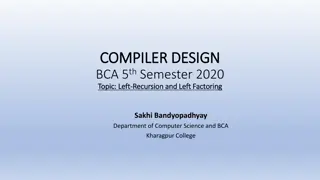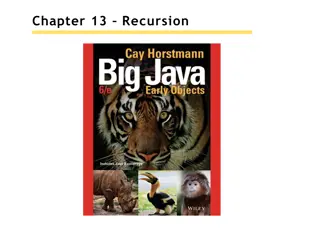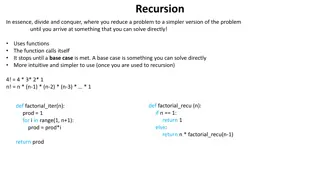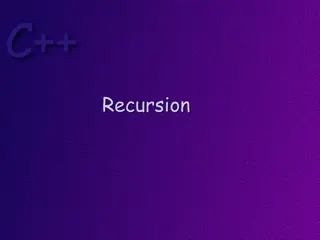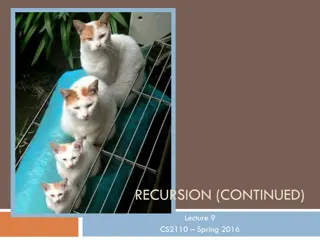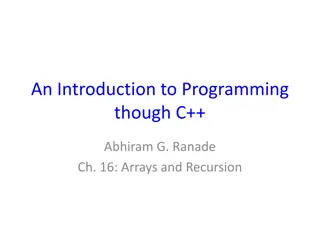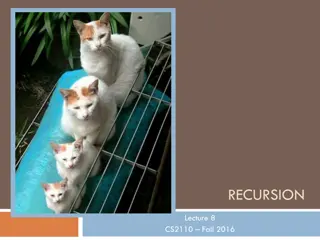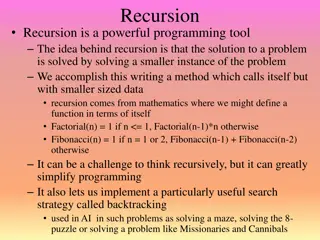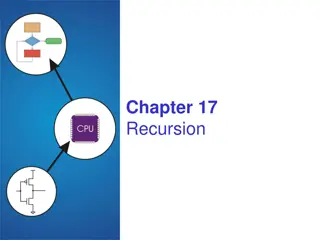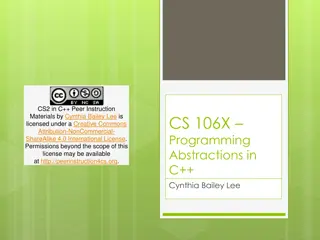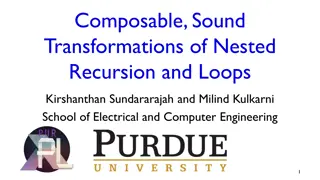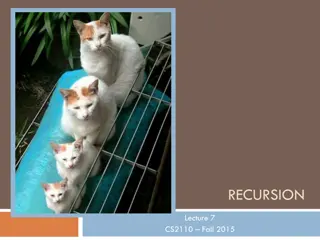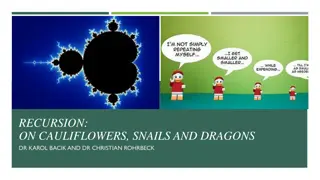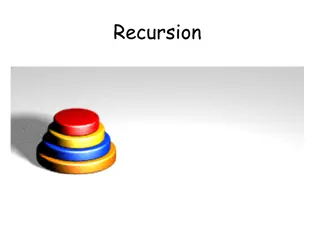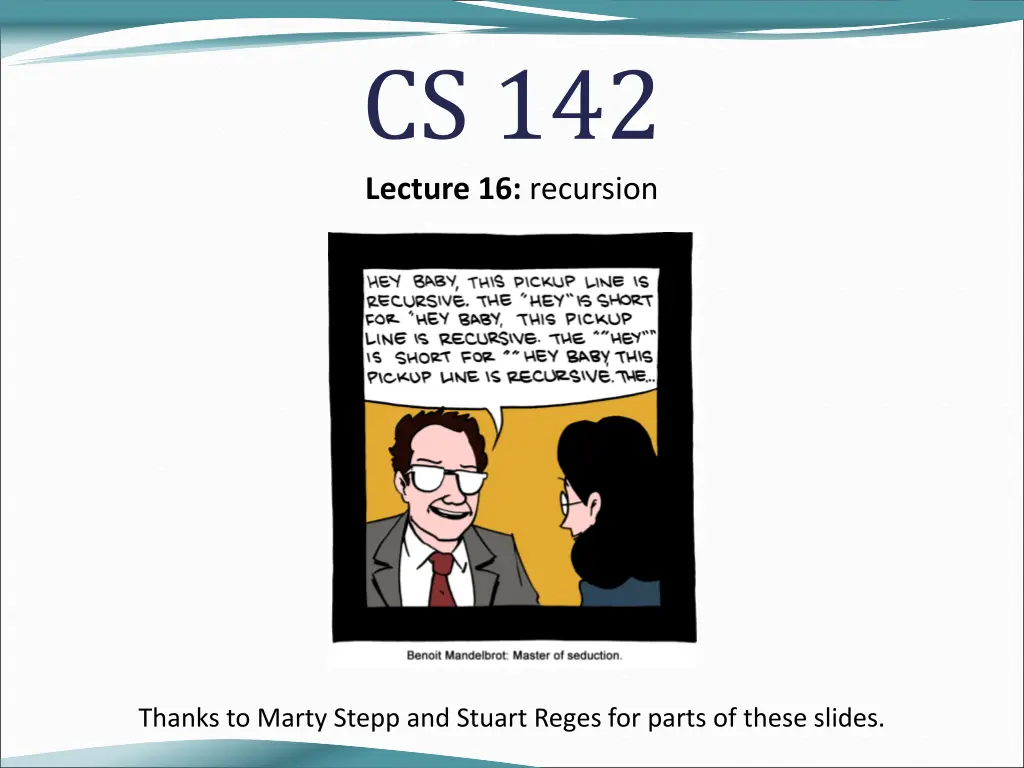
Understanding Recursion in Computer Science
Dive into the world of recursion in computer science with examples and explanations on base cases, recursive cases, and the art of recursion zen. Learn how to apply recursion properly and tackle recursive tasks efficiently. Explore the concept of removing M&M's, identifying cases, and reversing file lines through recursion.
Download Presentation

Please find below an Image/Link to download the presentation.
The content on the website is provided AS IS for your information and personal use only. It may not be sold, licensed, or shared on other websites without obtaining consent from the author. If you encounter any issues during the download, it is possible that the publisher has removed the file from their server.
You are allowed to download the files provided on this website for personal or commercial use, subject to the condition that they are used lawfully. All files are the property of their respective owners.
The content on the website is provided AS IS for your information and personal use only. It may not be sold, licensed, or shared on other websites without obtaining consent from the author.
E N D
Presentation Transcript
CS 142 Lecture 16: recursion Thanks to Marty Stepp and Stuart Reges for parts of these slides.
Another recursive task How can we remove exactly half of the M&M's in a large bowl, without dumping them all out or being able to count them? What if multiple people help out with solving the problem? Can each person do a small part of the work? What is a number of M&M's that it is easy to double, even if you can't count? 2
Recursion and cases Every recursive algorithm involves at least 2 cases: base case: A simple occurrence that can be answered directly. recursive case: A more complex occurrence of the problem that cannot be directly answered, but can instead be described in terms of smaller occurrences of the same problem. Some recursive algorithms have more than one base or recursive case, but all have at least one of each. A crucial part of recursive programming is identifying these cases. 3
Using recursion properly Condensing the recursive cases into a single case: public static void printStars(int n) { if (n == 1) { // base case; just print one star System.out.println("*"); } else { // recursive case; print one more star System.out.print("*"); printStars(n - 1); } } 4
"Recursion Zen" The real, even simpler, base case is an n of 0, not 1: public static void printStars(int n) { if (n == 0) { // base case; just end the line of output System.out.println(); } else { // recursive case; print one more star System.out.print("*"); printStars(n - 1); } } Recursion Zen: The art of properly identifying the best set of cases for a recursive algorithm and expressing them elegantly. (A CS 142 informal term) 5
Exercise Write a recursive method reverseLines that accepts a file Scanner and prints the lines of the file in reverse order. Example input file: Expected console output: I have eaten the plums that were in the icebox the icebox that were in the plums I have eaten What are the cases to consider? How can we solve a small part of the problem at a time? What is a file that is very easy to reverse? 6
Reversal pseudocode Reversing the lines of a file: Read a line L from the file. Print the rest of the lines in reverse order. Print the line L. If only we had a way to reverse the rest of the lines of the file.... 7
Reversal solution public static void reverseLines(Scanner input) { if (input.hasNextLine()) { // recursive case String line = input.nextLine(); reverseLines(input); System.out.println(line); } } Where is the base case? 8
Tracing our algorithm call stack: The method invocations currently running reverseLines(new Scanner("poem.txt")); public static void reverseLines(Scanner input) { if (input.hasNextLine()) { String line = input.nextLine(); // "I have eaten" reverseLines(input); System.out.println(line); } } reverseLines(input); System.out.println(line); } } reverseLines(input); System.out.println(line); } } reverseLines(input); System.out.println(line); } } } } public static void reverseLines(Scanner input) { if (input.hasNextLine()) { String line = input.nextLine(); // "the plums" public static void reverseLines(Scanner input) { if (input.hasNextLine()) { String line = input.nextLine(); // "that were in" public static void reverseLines(Scanner input) { if (input.hasNextLine()) { String line = input.nextLine(); // "the icebox" public static void reverseLines(Scanner input) { if (input.hasNextLine()) { // false ... input file: I have eaten the plums that were in the icebox output: the icebox that were in the plums I have eaten 9
Recursive tracing Consider the following recursive method: public static int mystery(int n) { if (n < 10) { return n; } else { int a = n / 10; int b = n % 10; return mystery(a + b); } } What is the result of the following call? mystery(648) 10
A recursive trace mystery(648): int a = 648 / 10; // 64 int b = 648 % 10; // 8 return mystery(a + b); // mystery(72) mystery(72): int a = 72 / 10; // 7 int b = 72 % 10; // 2 return mystery(a + b); // mystery(9) mystery(9): return 9; 11
Recursive tracing 2 Consider the following recursive method: public static int mystery(int n) { if (n < 10) { return (10 * n) + n; } else { int a = mystery(n / 10); int b = mystery(n % 10); return (100 * a) + b; } } What is the result of the following call? mystery(348) 12
A recursive trace 2 mystery(348) int a = mystery(34); int a = mystery(3); return (10 * 3) + 3; // 33 int b = mystery(4); return (10 * 4) + 4; // 44 return (100 * 33) + 44; // 3344 int b = mystery(8); return (10 * 8) + 8; // 88 return (100 * 3344) + 88; // 334488 What is this method really doing? 13
Exercise Write a recursive method pow accepts an integer base and exponent and returns the base raised to that exponent. Example: pow(3, 4) returns 81 Solve the problem recursively and without using loops. 14
An optimization Notice the following mathematical property: 312 = 531441 = 96 = (32)6 = (92)3 = ((32)2)3 531441 When does this "trick" work? How can we incorporate this optimization into our pow method? What is the benefit of this trick if the method already works? 15
Exercise Write a recursive method printBinary that accepts an integer and prints that number's representation in binary (base 2). Example: printBinary(7) prints 111 Example: printBinary(12) prints 1100 Example: printBinary(42) prints 101010 place 10 1 32 16 8 4 2 1 value 4 2 1 0 1 0 1 0 Write the method recursively and without using any loops. 17
Stutter How did we break the number apart? public static int stutter(int n) { if (n < 10) { return (10 * n) + n; } else { int a = mystery(n / 10); int b = mystery(n % 10); return (100 * a) + b; } } 18
Case analysis Recursion is about solving a small piece of a large problem. What is 69743 in binary? Do we know anything about its representation in binary? Case analysis: What is/are easy numbers to print in binary? Can we express a larger number in terms of a smaller number(s)? 19
printBinary solution // Prints the given integer's binary representation. // Precondition: n >= 0 public static void printBinary(int n) { if (n < 2) { // base case; same as base 10 System.out.println(n); } else { // recursive case; break number apart printBinary(n / 2); printBinary(n % 2); } } Can we eliminate the precondition and deal with negatives? 20

